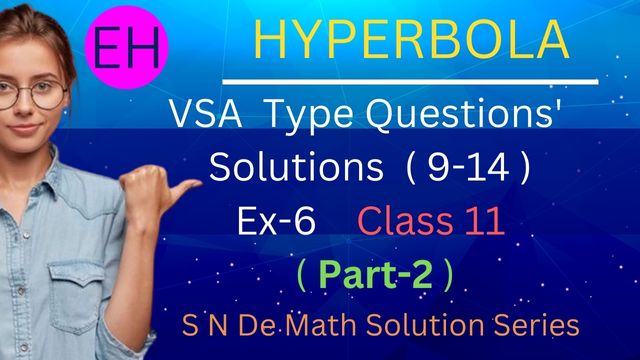In the previous article , we have solved few VSA type questions of Hyperbola chapter of S.N.Dey mathematics, Class 11. In this article , we will solve few more questions of Hyperbola related problems.

9(i) If the length of latus rectum of a rectangular hyperbola is ![]() unit, find its equation.
unit, find its equation.
Solution.
The length of the latus rectum is ![]()
For rectangular hyperbola, ![]()
So, from ![]() we get,
we get,
![]()
Hence, the equation of the rectangular hyperbola is given by
![]()
(ii) Find the co-ordinates of the foci of the rectangular hyperbola ![]()
Solution.
Comparing the given hyperbola ![]() with
with ![]() we get,
we get, ![]() Also, we know that the eccentricity
Also, we know that the eccentricity ![]() of any rectangular hyperbola is
of any rectangular hyperbola is ![]()
The co-ordinates of the foci is given by
![]()
10. If the latus rectum and the transverse axis of a hyperbola are equal, show that it is a rectangular hyperbola.
Solution.
We know that the length of latus rectum of the hyperbola ![]() is
is ![]() unit and the transverse axis is given by
unit and the transverse axis is given by ![]() unit.
unit.
By question,
![]()
Hence, by ![]() we get,
we get,
![]()
So, the given hyperbola is a rectangular hyperbola.
11. Find the positions of the points with respect to the hyperbola ![]()
![]()
Solution(i)
We know that the point ![]() lies outside, on or inside the hyperbola
lies outside, on or inside the hyperbola ![]() according as
according as
![]()
The given equation of the hyperbola can be written as
![]()
Now, for the point ![]() we get,
we get,
![]()
Hence, by ![]() and
and ![]() we can conclude that the point
we can conclude that the point ![]() lies inside the given hyperbola.
lies inside the given hyperbola.
Solution(ii)
We know that the point ![]() lies outside, on or inside the hyperbola
lies outside, on or inside the hyperbola ![]() according as
according as
![]()
The given equation of the hyperbola can be written as
![]()
Now, for the point ![]() we get,
we get,
![]()
Hence, by ![]() and
and ![]() we can conclude that the point
we can conclude that the point ![]() lies inside the given hyperbola.
lies inside the given hyperbola.
Solution(iii)
We know that the point ![]() lies outside, on or inside the hyperbola
lies outside, on or inside the hyperbola ![]() according as
according as
![]()
The given equation of the hyperbola can be written as
![]()
Now, for the point ![]() we get,
we get,
![]()
Hence, by ![]() and
and ![]() we can conclude that the point
we can conclude that the point ![]() lies outside the given hyperbola.
lies outside the given hyperbola.
12. Find the position of the point ![]() with respect to the hyperbola
with respect to the hyperbola ![]()
Solution.
We know that the point ![]() lies outside, on or inside the hyperbola
lies outside, on or inside the hyperbola ![]() according as
according as
![]()
The given equation of the hyperbola can be written as
![]()
Now, for the point ![]() we get,
we get,
![]()
Hence, by ![]() and
and ![]() we can conclude that the point
we can conclude that the point ![]() lies inside the given hyperbola.
lies inside the given hyperbola.
13. Show that the locus of the point of intersection of the lines ![]() and
and ![]() being a variable parameter, is a hyperbola.
being a variable parameter, is a hyperbola.
Solution.
The given equations of straight lines are
![]()
From ![]() and
and ![]() we get,
we get,

Hence, by ![]() we can conclude that the locus of point of intersection of the given lines is a hyperbola.
we can conclude that the locus of point of intersection of the given lines is a hyperbola.
14. Find the parametric co-ordinates of the point ![]() on the hyperbola
on the hyperbola ![]()
Solution.
The equation of the hyperbola can be written as

Comparing ![]() with
with ![]() we get,
we get,
![]()
So, we can say that the any point on the hyperbola ![]() can be written in parametric form as
can be written in parametric form as ![]()
![]() By question,
By question,

Hence, the parametric co-ordinates of the given point can be written as
![]()